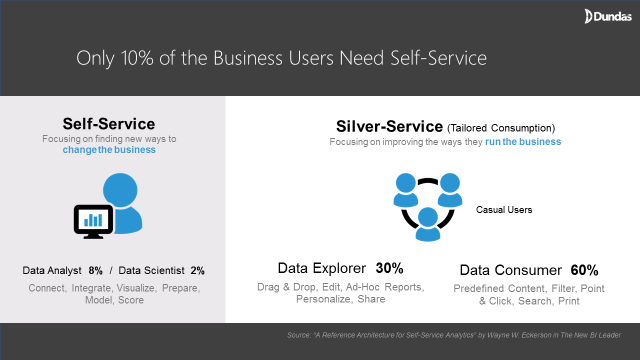I recently had the chance to brief the Boulder Business Intelligence Brain Trust (BBBT) community on Dundas’ latest offering.
For those of you who are unfamiliar with the BBBT community, it is a great assembly of independent BI analysts and experts, who are very knowledgeable of the industry and as such, are able to offer unbiased opinions of what practices really work in our industry and what products can truly make a difference. Fluff won’t fly with the BBBT community, which is a big part of why I genuinely enjoy discussions with them; it’s important to have strong arguments backed by solid proof.
During our discussion, I made a rather shocking claim that caught the BBBT off-guard:
“Only 10% of the Business Users Need Self-Service”

In today’s BI world, such a claim can be dangerous because everybody wants to be self-sufficient when it comes to their data. But is analyzing data and answering new questions daily something that everybody wants to do? Does everybody actually want to be able to blend data with new sources on the fly? Do most business users even know what blending data means? Even if they are able to do more advanced data preparation, do they have the time to do so, while testing and fiddling with the data results? I believe, and based on the discussion with the BBBT group, many agree with me, that most business users are not really looking for Self-Service but in actuality are looking for what Wayne Eckerson calls “Silver-Service”. Silver-Service is achieved when the data that business users need in order to run their business, is offered on a silver platter – intuitive and easy to consume as much as possible. Presented in a way that doesn’t require business users to understand and learn how a software operates but instead, in a manner that works exactly as they would expect it to work, tailored to their way of consuming and exploring the data.
This doesn’t mean I don’t think there’s a need to offer self-service capabilities for the analyst users in the business, but I do think that a tool that is designed primarily with the analyst in mind, will not be beneficial to the majority of business users. It will not be very easy to use by those who don’t need the same advanced capabilities and typically don’t have even have the skills to use them. The majority of the business users need BI in a way that works for them and that often means it must be/have:
- Intuitive
- Point-and-Click
- Easy Report Interactivity with No Training Required
- A Personalized Design
- Beautiful, “Sexy Dashboards”
- Customized to your Preferences
- Easily Accessible
- Alerts and Scheduled Reports sent Straight to your Inbox
- Live Web Sharing
With Dundas BI – we solve this issue and provide an experience that adapts to the user. We provide the analysts and BI professionals with the right tools to create their data analysis, while allowing them to easily turn those into beautiful reports that can be shared with the majority of users in a way that works for them.
One final note in case you spent time digesting the image above - we could further debate whether data explorers should be categorized under the Silver-Service or Self-Service group. In my mind, they identify as Silver-Service as their data exploration is typically effective if done under a predefined data model that allows them to make no mistakes when querying the data (or else they won’t trust themselves to use it).


Follow Us
Support